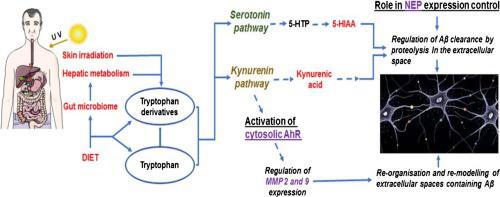Progress in Neurobiology ( IF 6.7 ) Pub Date : 2020-04-29 , DOI: 10.1016/j.pneurobio.2020.101800 Michel Maitre 1 , Christian Klein 1 , Christine Patte-Mensah 1 , Ayikoe-Guy Mensah-Nyagan 1

|
Among several processes, a decrease in amyloid-beta (Aβ) peptide elimination is thought to be one of the major pathophysiological factors in Alzheimer’s disease (AD). Neprilysin (NEP) is a key metalloproteinase controlling the degradation and clearance of Aβ peptides in the brain. NEP is induced by several pharmacological substances, amyloid deposits and somatostatin, but the physiological regulation of its expression remains unclear. This situation hampers the exploitation of NEP regulatory factors/mechanisms to develop effective strategies against Aβ peptide accumulation-induced brain toxicity. Based on recent data aimed at elucidating this major question, the present paper addresses and critically discusses the role of 5-hydroxyindole-acetic acid (5-HIAA) and kynurenic acid (KYNA) in the regulation of NEP activity/expression in the brain. Both 5-HIAA and KYNA are endogenous metabolites of tryptophan, an essential amino-acid obtained through diet and gut microbiome. By interacting with the aryl hydrocarbon receptor, various tryptophan metabolites modulate several metalloproteinases regulating brain Aβ peptide levels under normal and pathological conditions such as AD. In particular, interesting data reviewed here show that 5-HIAA and KYNA stimulate NEP activity/expression to prevent Aβ peptide-induced neurotoxicity. These data open promising perspectives for the development of tryptophan metabolite-based therapies against AD.
中文翻译:

色氨酸代谢物修饰大脑Aβ肽降解:在阿尔茨海默氏病中起作用?
在几个过程中,淀粉样蛋白(Aβ)肽消除的减少被认为是阿尔茨海默氏病(AD)的主要病理生理因素之一。脑啡肽酶(NEP)是控制脑中Aβ肽降解和清除的关键金属蛋白酶。NEP由几种药理物质,淀粉样蛋白沉积物和生长抑素诱导,但其表达的生理调控仍不清楚。这种情况妨碍了利用NEP调节因子/机制来开发有效的策略来对抗Aβ肽蓄积引起的脑毒性。基于旨在阐明这一主要问题的最新数据,本论文着重讨论了5-羟吲哚乙酸(5-HIAA)和动尿酸(KYNA)在调节脑内NEP活性/表达中的作用。5-HIAA和KYNA都是色氨酸的内源性代谢产物,色氨酸是通过饮食和肠道微生物组获得的必需氨基酸。通过与芳基烃受体相互作用,各种色氨酸代谢产物可调节几种金属蛋白酶,调节正常和病理状况(例如AD)中的大脑Aβ肽水平。特别是,这里审查的有趣数据表明,5-HIAA和KYNA刺激NEP活性/表达,以预防Aβ肽诱导的神经毒性。这些数据为开发基于色氨酸代谢物的AD疗法开辟了广阔的前景。在正常和病理条件下,例如AD,各种色氨酸代谢产物可调节多种金属蛋白酶,调节脑Aβ肽水平。特别是,这里审查的有趣数据表明,5-HIAA和KYNA刺激NEP活性/表达,以预防Aβ肽诱导的神经毒性。这些数据为开发基于色氨酸代谢物的AD疗法开辟了广阔的前景。在正常和病理条件下,例如AD,各种色氨酸代谢产物可调节多种金属蛋白酶,调节脑Aβ肽水平。特别是,这里审查的有趣数据表明,5-HIAA和KYNA刺激NEP活性/表达,以预防Aβ肽诱导的神经毒性。这些数据为开发基于色氨酸代谢物的AD疗法开辟了广阔的前景。







































 京公网安备 11010802027423号
京公网安备 11010802027423号